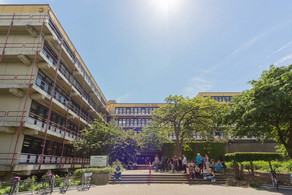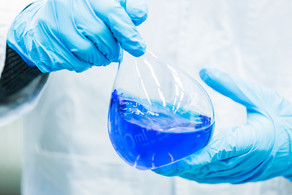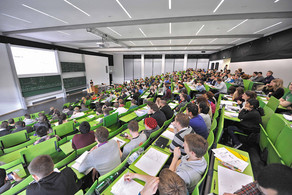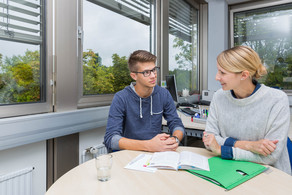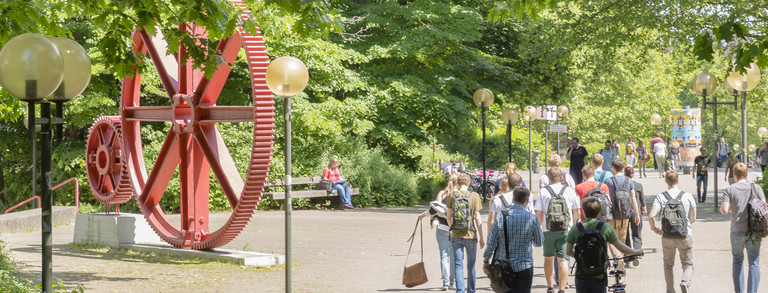Teaching
Courses (since 1997/98)
| WS 2022/23 | Biophysikalische Chemie - Methoden und Anwendungen |
| WS 2021/22 | Physikalische Chemie 2 (Thermodynamik, Grenzflächenerscheinungen, Elektrochemie) |
| SS 2021 | Physikalische Chemie 1 (Aggregatzustände der Materie, Kinetische Gastheorie, Chemische Kinetik) |
| WS 2019/20 | Physikalische Chemie 4 (Statistische Thermodynamik) |
| SS 2019 | Physikalische Chemie 3 (Quantentheorie, Atombau und Chemische Bindung, Molekülspektroskopie) |
| WS 2018/19 | Physikalische Chemie 2 (Thermodynamik, Grenzflächenerscheinungen, Elektrochemie) Biophysikalische Chemie - Methoden und Anwendungen (Winter/Czeslik) |
| SS 2018 | Physikalische Chemie 1 (Aggregatzustände der Materie, Kinetische Gastheorie, Chemische Kinetik) |
| SS 2017 | Spezielle Physikalische Chemie: Struktur und Dynamik von Biomolekülen |
| WS 2016/17 | Physikalische Chemie 4 (Statistische Thermodynamik) |
| SS 2016 | Physikalische Chemie 3 (Quantentheorie, Atombau und Chemische Bindung, Molekülspektroskopie) Spezielle Physikalische Chemie: Struktur und Dynamik von Biomolekülen |
| WS 2015/16 | Physikalische Chemie 2 (Thermodynamik, Grenzflächenerscheinungen, Elektrochemie) Biophysikalische Chemie - Methoden und Anwendungen |
| SS 2015 | Physikalische Chemie 1 (Aggregatzustände der Materie, Kinetische Gastheorie, Chemische Kinetik) Spezielle Physikalische Chemie: Struktur und Dynamik von Biomolekülen |
| WS 2014/15 | Biophysikalische Chemie - Methoden und Anwendungen |
| SS 2014 | Spezielle Physikalische Chemie: Struktur und Dynamik von Biomolekülen |
| WS 2013/14 | Biophysikalische Chemie - Methoden und Anwendungen |
| SS 2013 | Spezielle Physikalische Chemie: Struktur und Dynamik von Biomolekülen |
| WS 2012/13 | Biophysikalische Chemie - Methoden und Anwendungen |
| SS 2012 | Spezielle Physikalische Chemie: Struktur und Dynamik von Biomolekülen |
| WS 2011/12 | Biophysikalische Chemie - Methoden und Anwendungen |
| SS 2010 | Spezielle Physikalische Chemie: Struktur und Dynamik von Biomolekülen (C. Czeslik) |
| WS 2010/11 | Physikalische Chemie 4 (Statistische Thermodynamik) Biophysikalische Chemie - Methoden und Anwendungen (C. Czeslik) |
| SS 2010 | Physikalische Chemie 3 (Quantentheorie, Atombau und Chemische Bindung, Molekülspektroskopie) Spezielle Physikalische Chemie: Struktur und Dynamik von Biomolekülen (C. Czeslik) |
| WS 2009/10 | Biophysikalische Chemie - Methoden und Anwendungen (R. Winter) Physikalische Chemie 2 (Thermodynamik, Grenzflächenerscheinungen, Elektrochemie) (C. Czeslik) |
| SS 2009 | Biophysikalische Chemie - Methoden und Anwendungen (C. Czeslik) Physikalische Chemie 1 (Aggregatzustände der Materie, Kinetische Gastheorie, Chemische Kinetik) |
| WS 2008/09 | Spezielle Physikalische Chemie: Struktur und Dynamik von Biomolekülen (C. Czeslik) |
| SS 2008 | Biophysikalische Chemie - Methoden und Anwendungen |
| WS 2007/08 | Physikalische Chemie 4 (Statistische Thermodynamik) Struktur und Dynamik von Biomolekülen Membrane Biophysics (International Max-Planck Research School) |
| SS 2007 | Physikalische Chemie 3 (Quantentheorie, Atombau und Chemische Bindung, Molekülspektroskopie) |
| WS 2006/07 | Physikalische Chemie 2 (Thermodynamik, Grenzflächenerscheinungen, Elektrochemie) Struktur und Dynamik von Biomolekülen |
| SS 2006 | Physikalische Chemie 1 (Aggregatzustände der Materie, Kinetische Gastheorie, Chemische Kinetik) Membrane Biophysics (International Max-Planck Research School) |
| WS 2005/06 | Membran-Biophysik |
| SS 2005 | Biophysikalische Chemie - Methoden und Anwendungen |
| SS 2004 | Physikalische Chemie II Biophysikalische Chemie - Methoden und Anwendungen Spectroscopic Techniques in Bioscience (International Max-Planck Research School) |
| WS 2003/04 | Physikalische Chemie I |
| SS 2003 | Biophysikalische Chemie - Methoden und Anwendungen Membrane Biophysics (International Max-Planck Research School) |
| WS 2002/03 | Grundlagen der Chemie (physikalisch-chemischer Teil) |
| SS 2002 | Biophysikalische Chemie - Methoden und Anwendungen Methods in Biophysical Chemistry (International Max-Planck Research School) |
| WS 2001/02 | Molekülspektroskopie |
| SS 2001 | Biophysikalische Chemie - Methoden und Anwendungen Biologische Chemie (physikalisch-chemischer Teil) |
| WS 2000/01 | Ausgewählte Kapitel aus der Statistischen Thermodynamik |
| SS 2000 | Ausgewählte Kapitel aus der Molekülspektroskopie Biologische Chemie (physikalisch-chemischer Teil) |
| WS 1999/00 | Ausgewählte Kapitel aus der Atomistik und chemischen Bindung |
| SS 1999 | Ausgewählte Kapitel aus der Biophysikalischen Chemie |
| WS 1998/99 | Ausgewählte Kapitel aus der Reaktionskinetik |
| SS 1998 | Physikalische Chemie II (Atomistik, Spektroskopie, Statistik) |
| WS 1997/98 | Physikalische Chemie I (Thermodynamik, Elektrochemie, Reaktionskinetik) |
Practical courses
Praktika der Physikalischen Chemie im Grund- und Hauptstudium

